CES 2020: Preview of tomorrow's tech on show in Las Vegas
How much tech can you take? Next week aims to stretch your horizons, as well as your credulity, as thousands of new products are launched and demoed at the giant CES expo.
Artificial intelligence, 5G, foldables, surveillance tech, 8K and robotics are set to be among this year's buzzwords.
But also expect Trump to feature. The President's clashes with China have led some of the communist country's biggest tech firms to cancel or reduce their involvement in the Las Vegas event. But the prospect of an imminent trade deal points towards tensions easing and greater access to Chinese consumers.
Ivanka Trump - the US leader's daughter - is also attending to give a "keynote" interview to CES chief Gary Shapiro.
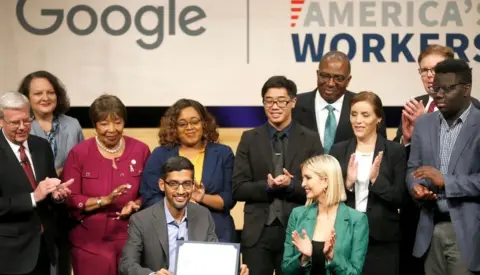 Getty Images
Getty ImagesHe once called on Americans to oppose her father because of "his racism and inanity".
Now Mr Shapiro faces criticism himself for inviting Ivanka to discuss "the future of work". Critics claim she is benefiting from nepotism while better-qualified female tech champions are overlooked.
But some of Silicon Valley's most powerful women are taking part.
Apple's privacy chief Jane Horvath is making a rare public appearance. It's the first time her company has formally been involved in CES since it hawked its Newton handheld back in 1992.
In addition, ex-Hewlett Packard chief Meg Whitman will co-host another keynote with former Dreamworks co-founder Jeffrey Katzenberg, to showcase Quibi. The platform aims to outmanoeuvre Netflix and Amazon on mobile with a range of 10-minute-long shows.
 Getty Images
Getty ImagesBut the reason CES generates so much interest is its gadgets. Here are our hot spots from this years show:
SMART HOME
Amazon and Google will once again be hiring out lots of floor space to spotlight products that tie into their virtual assistants.
The success of their smart speakers helped global demand for net-connected home products grow by a healthy 24% in unit terms in 2019, according to research firm IDC.
The challenge at this point is to pioneer new types of devices, rather than tweak what is already on the market.
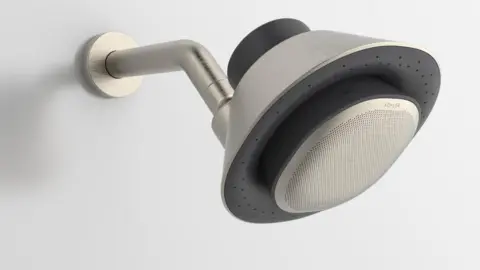 Kohler
KohlerBathroom specialist Kohler is already attracting attention for Moxie. The shower head integrates an Alexa-enabled speaker and microphone - but thankfully no camera.
Meanwhile many of CES's smaller start-ups have looked to the kitchen for inspiration.
 SmartyPans
SmartyPansSmartypans has a frying pan that checks the weight and temperature of ingredients before guiding you through the cooking process via an app.
Inirv wants you to swap your cooker's knobs for its smart dials.
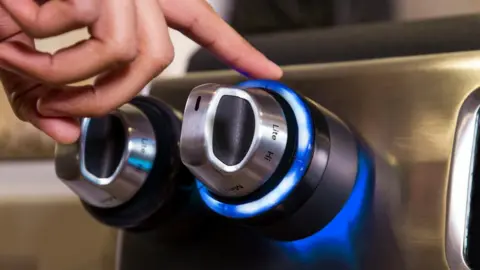 Inirv
InirvThey let owners turn up the heat via voice command, and automatically turn off the stove if it is left unattended for too long.
And PantryOn aims to automate food shopping lists via smart shelves that monitor when a family's favourite groceries run low.
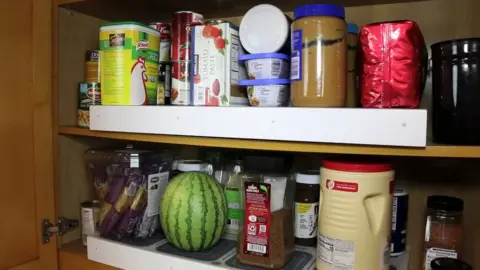 PantryOn
PantryOnThe caveat is that its current prototypes look to be quite bulky, leaving less storage space as a result.
Not all home tech requires an always-on net connection.
BrightLock unlocks front doors by detecting a pattern of light pulses fired from a smartphone's flash.
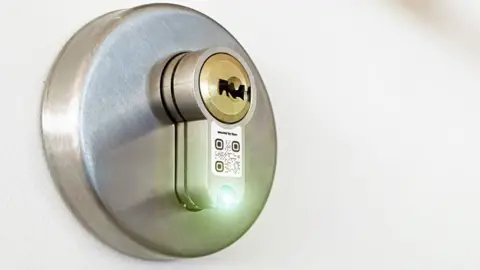 Brightlock
BrightlockThe idea is that you can easily share a light-based code with friends, tradesmen or others needing temporary access.
Townew promises to liberate you from the toil of having to tie up rubbish bags.
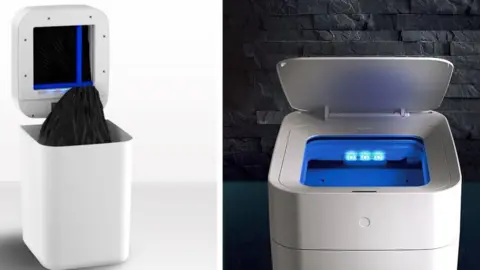 Townew
TownewThe bin self-seals sacks at the touch of a button, but requires you to be locked into buying the manufacturer's bin liner refills.
And Lua wants to "turn your plant into a pet" with a sensor-packed pot that shows animated faces to let you know when your foliage is thirsty, or in need of sunlight.
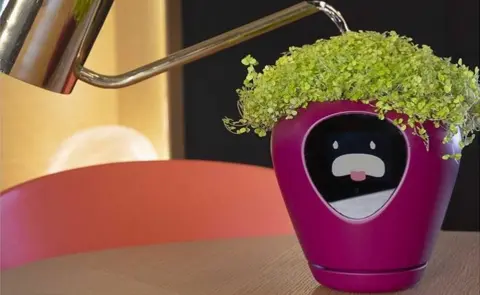 Lua
LuaOne theme to watch out for is the further rise of the pod, with a number of companies seeking to emulate Nespresso's coffee capsules.
They include Tigout, whose machine makes bite-sized bakes and souffles, and AI-Plus Plantbox, a smart-farming appliance that turns pods full of seeds into small batches of vegetables and herbs.
 Tigout/AIPlus
Tigout/AIPlusOne further home-tech trend is smaller appliances for compact homes.
Morus Zero is a countertop tumble dryer that uses a vacuum-based system to dry clothes.
Its makers claim the technology makes it more energy-efficient than traditional heat-based models. But they may have to address concerns raised by some crowdfunder backers about whether it's possible to deliver what has been promised.
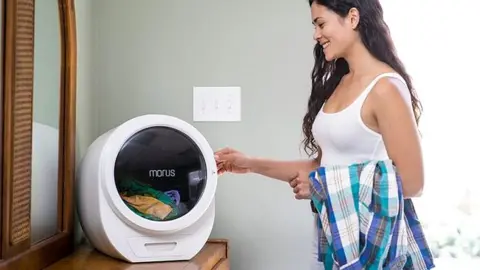 Morus
MorusDaanTech's Bob is another example, with what it claims is the world's smallest dishwasher.
It only has space for two people's tableware. Surely the sink wouldn't take too much longer?
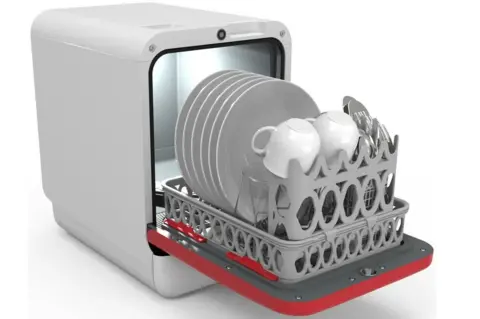 DaanTech
DaanTechThere will be lots of new home security products too.
Ring should expand its portfolio of thief-deterrent tech, but will this be the moment it upgrades its surveillance capabilities? Its parent Amazon has the AI know-how, but may be biding its time to avoid controversy.
Others aren't hanging about.
Amaryllo will promote Athena, a security camera that recognises people's voices and faces, to distinguish friends and family from strangers.
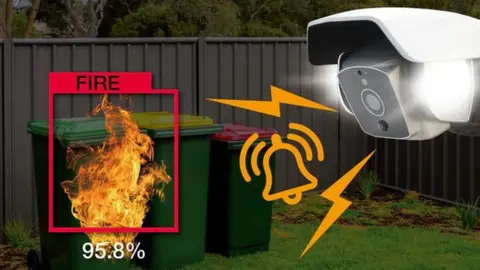 Amaryllo
AmarylloFurthermore, it can recognise a fire from afar and raise the alarm.
TELEVISIONS
TVs have been at the heart of CES since its start.
It looks like the big news this time will be a no-bezel edge-to-edge screen from Samsung and a flexible OLED model from LG that rolls down from the ceiling. The question for both is whether the impressive engineering involved comes at the cost of fragility.
 LG Display
LG DisplayThere's also likely to be a big push to take 8K mass-market. The tech features four times as many pixels as 4K sets and 16 times as many as 1080p screens.
Tokyo's Summer Olympics are being filmed in the "super hi-vision" format, but it's still unclear which broadcasters will support it beyond Japan's NHK and Italy's Rai.
With little other 8K content, TV-makers are under pressure to prove that their upscaling technologies noticeably enhance lower-resolution Blu-Ray disks and video-streams. It can take considerable computing smarts to do this well, but several companies say they have trained "deep learning" systems that are capable of the task.
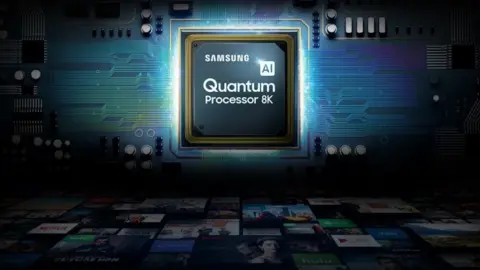 Samsung
SamsungAs if the differences between LED, OLED, QLED and microLED were not baffling enough, there will be a new technology in town: Mini-LED.
This involves using smaller light-emitting diodes than normal, to illuminate a screen's colour pixels. This allows there to be more distinct lighting zones, which in turn should reduce the blooming effect you sometimes get when light spills from bright objects in a scene into surrounding darker areas.
It won't produce the deep blacks of OLED, where each pixel is self-illuminating. Nor will it match microLED tech, where the diodes are so small they can be assigned to the pixels on a 1:1 basis.
But it should deliver an impressive HDR (high dynamic range) picture at a relatively affordable price.
Allow X content?
TCL has confirmed it will launch Mini-LED TVs at CES, and other brands may do so too, even if they call them by another name.
Also look out to see which brands adopt the new Filmmaker Mode.
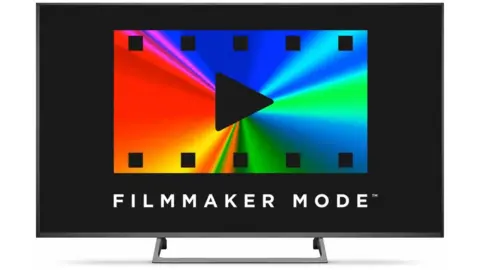 UHD Alliance
UHD AllianceA number of Hollywood directors, including Martin Scorsese, James Cameron and Christopher Nolan, have spearheaded an initiative to let TVs display movies as their creators intended.
At a single button push, motion-blurring is switched off, and the colours, frame rate and aspect ratio are all adjusted.
LG, Panasonic and Vizio have already indicated they will adopt this in at least some new TVs.
ROBOTS & AI
Samsung's skunkworks unit Star Labs has teased Neon in the run-up to CES 2020.
It is described as being an "artificial human" but little else has been confirmed beyond the fact it isn't intended to replace the firm's Bixby virtual assistant. All will be revealed on Monday.
 Samsung
SamsungOther companies have been more forthcoming about their robo-plans.
Picnic will show off a machine that can prepare up to 300 pizzas an hour, each with a customised set of toppings controlled by an app. The start-up has ambitions to extend into sandwiches, salads and tortillas soon, and is pitching the product at restaurant chains, rather than consumers.
 Picnic
PicnicOther robots on show will be more focused on keeping us entertained, rather than concentrating on the workplace.
China's Elephant Robotics will demo MarsCat. It's a kind of feline twist on Sony's robo-dog Aibo - it can play with toys, recognise its owner's voice and even interact with real cats.
 Elephant Robotics
Elephant RoboticsBut what extends its appeal is that it runs off a Raspberry Pi, which means it is programmable and can be used to teach students to code AI applications.
At the other end of the scale, Tombot will promote its robotic labrador puppy. The touch-sensitive machine is designed to provide comfort to residents in old people's homes, and others who would benefit from a pet, but cannot deal with a real animal.
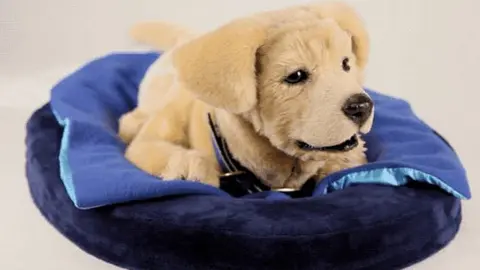 Tombot
Tombot It has been designed by Jim Henson's Creature Shop - the team behind the Muppets - and is certainly cute, if limited in function.
Pibo looks set to be a trickier sell. The humanoid robot with a camera in its mouth is being pitched at teenage girls. Marketing videos show it taking photos of them and their food, recording their diary entries and telling them it loves them. It seems odd and a little creepy.
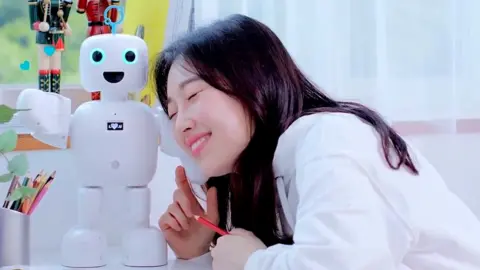 Circulus
CirculusYukai's Bocco robots may have a better chance of hitting the mark in the cuteness stakes.
They offer a way for children to send and receive voice messages to their parents, and babble back in their own language if addressed themselves.
They can also be paired with add-on sensors to disclose when a family member has arrived home, what the weather is doing and whether or not the front door was closed properly.
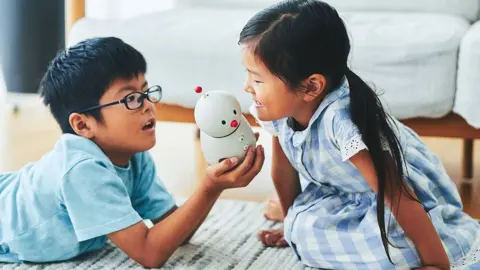 Yukai Engineering
Yukai EngineeringSwitching tack to software-focused AI, there's a tension between what can be done and how to prevent it.
For example, facial recognition specialist Cyberlink will demo its latest capabilities. They include using its FaceMe system to determine the age, gender and emotional state of passers-by, to show them appropriate ads.
 Cyberlink
CyberlinkBut D-ID is seeking to frustrate facial recognition checks with a program that makes minor changes to photos, to prevent people being recognised by computers even though they remain identifiable to the human eye.
It should give people a way to share images online with less risk of being tracked as a consequence.
 D-ID
D-IDElsewhere, Hour One will demo its synthetic character software.
It uses AI to create the video and voices of computer-generated characters.
Allow Google YouTube content?
In time, the company hopes to build up a bank of celebrities who will let their likenesses be leased to promote products, without the stars having to get directly involved.
Mirriad will be holding private meetings to show off a system that lets TVs and movies add brand placements after they have been shot.
Check out the results in our video above.
And keeping it quirky, Getcoo will exhibit its crowdfunded Lego-scanner.
The Piqabrick is a small cabinet that uses object recognition software to identify any part of the toy's vast library of pieces.
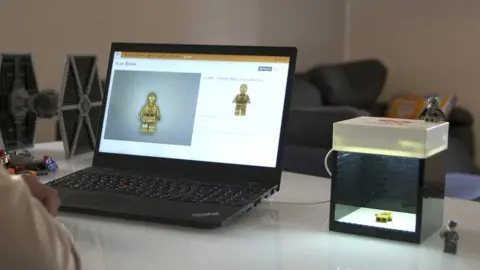 Getcoo
GetcooTRANSPORT
You can keep your self-driving cars (and there will be a lot of them).
Manta5's Hydrofoil e-bike offers a new way to travel that's ready to roll - or at least glide.
 Manta5
Manta5The water cycle's pedals push a propeller, and in the place of wheels there are wing-like parts that create more lift the faster the user cycles. The rider's efforts are aided by an electric motor, which can help the e-bike achieve speeds of up to 13mph (21 km/h).
It's the first commercial product of its kind. But a decade's worth of R&D doesn't come cheap - each e-bike costs £5,800.
Staying off-shore, there's a number of companies pitching underwater drones for recreational use, or as a way to aid fishing expeditions. But one aquatic vehicle has the potential to save lives.
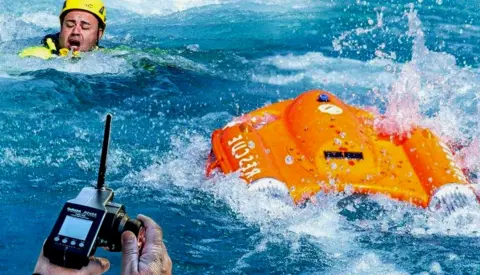 OceanAlpha
OceanAlphaOceanAlpha's Dolphin1 is a remote-controlled lifebuoy designed to save people at risk of drowning. Rescuers can avoid putting themselves at risk by staying out of the sea, and may even be in a better position to keep the victim in sight as a result.
Back on land, BMW, Mercedes-Benz, Hyundai and Nissan are among the automakers promising to show off new concept designs.
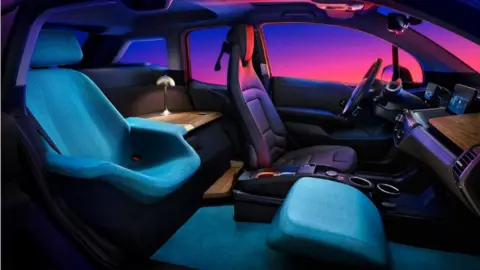 BMW
BMWThe Detroit Auto Show was previously held soon after CES. But this year it has shifted to June. That may give the car giants more scope to make real-world announcements, as well as show off dream designs.
For now though, only the electric car start-ups Byton and Fisker are certain to show off new models destined for production.
The former is hosting a press conference to demo the user interface of its forthcoming M-Byte four-wheel drive, which includes a "dark mode".
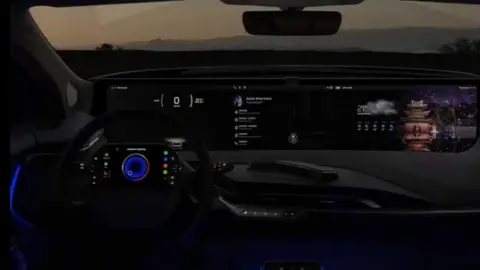 Byton
BytonThe latter will show off its Ocean car to the public for the first time.
It features a full-length solar panel roof to drip-feed the battery, although the tech is at least decades away from being capable of being the main power source.
 Fisker
FiskerThere will also be lots of chatter about new in-car infotainment experiences too.
Honda has said it will unveil its own virtual assistant, which can be summoned with the wake words "OK Honda".
LG will showcase webOS Auto, an operating system for internet-connected cars. It is based on the firm's much-commended smart TV system, but will face competition from the incumbents Apple Carplay and Android Auto.
 LG
LGMeanwhile, Bosch has been teasing a new kind of 3D display for car dashboards that doesn't require the driver to wear special glasses.
The firm claims that drivers' brains react more quickly to alerts as a consequence, in addition to it being able to show turnings on sat-nav maps more clearly.
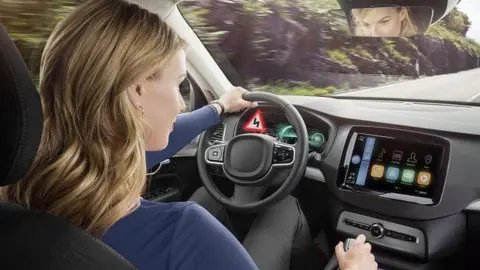 Bosch
BoschElsewhere, scooter giant Segway Ninebot will demo a self-balancing, self-driving two-wheeler that can be summoned via an app.
It will also seek feedback to the Apex - its first motorcycle, which it has yet to commit to putting on sale.
 Segway
SegwayAnd French start-up Wello hopes to attract interest for an unusual compact three-wheeler.
It is designed for short journeys in which a single passenger is transported at up to 25mph (40km/h).
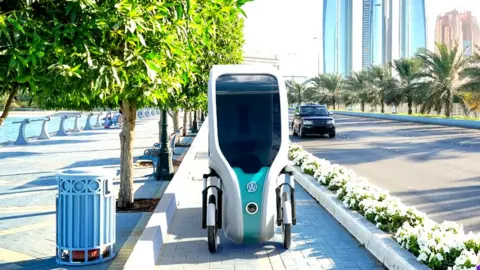 Wello
WelloHEALTH & WEARABLES
Beyond headphones, the wearable tech market has never taken off to the degree the industry had hoped for, with the possible exceptions of Apple's Watch and, in Asia, Xiaomi's wristbands.
Fitbit, once the dominant player, is set to be sold to Google, so may be quieter at this year's CES than in the past.
But others are hoping to make headway by aiming above the arm.
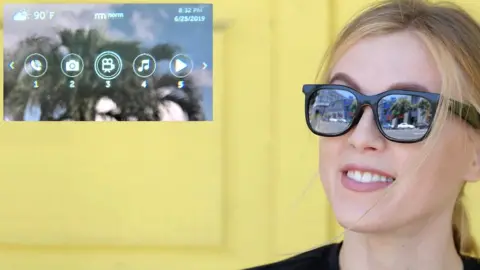 Human Capable
Human CapableThey include Human Capable, which will be showing off the Norm glasses.
It says they will be able to make calls, show directions and recipes, and both shoot and play videos - so a less geeky-looking Google Glass for the 2020s.
The start-up has already acknowledged problems with the noise-cancelling tech in the prototype it will exhibit, yet claims it will be able to launch a fixed product within months.
Waverly Labs is back at the expo with its second take on language-translating earbuds.
 Waverly Labs
Waverly LabsAmbassador lets up to four people chat by pairing their headsets to a single smartphone.
When the BBC tested it last month, there was a 2-3 second delay, but the firm says 5G networks should help it deliver near-instantaneous interpretations soon.
Plus, Ao Air has a face mask that looks like a cyberpunk movie prop.
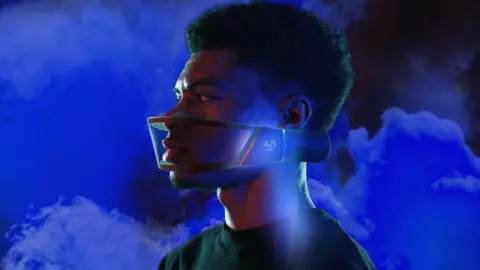 Ao Air
Ao AirThe Atmos uses a fan-based system to filter the air, and doesn't need a tight seal against the wearer's face. That means make-up shouldn't get smudged and glasses won't steam up, at least in theory.
Feet also get a look-in at the show.
Wahu is a pair of shoes that change the shape of their soles to suit the local environment.
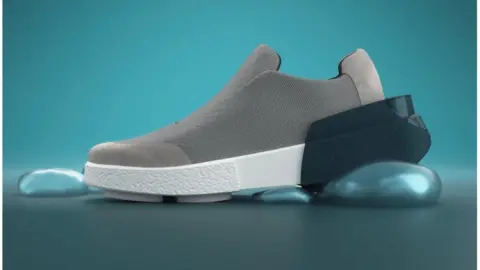 E-Novia
E-NoviaThe goal is to produce extra grip or cushioning, as required. The trick will be keeping both shoes in synch.
Staying with footwear, Shoeblast has a gadget that promises to prevent older shoes from stinking.
The device uses a humidity sensor to judge how much heat and ultraviolet light to apply to sterilise trainers.
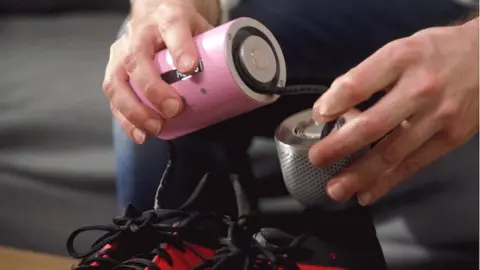 Shoeblast
ShoeblastOther body parts will be addressed by a new sex toys zone, which was created after last year's confusion about whether such products should be allowed on the show floor at all.
And there are also all kinds of new ways to address our wider physical health.
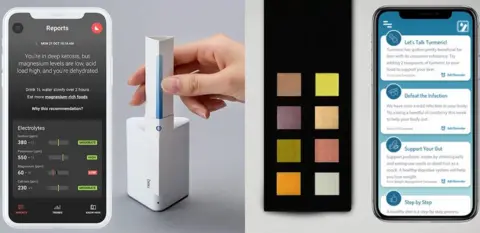 Bisu/Vivoo
Bisu/VivooThey include Bisu and Vivoo, rival pee-on-a-stick smart urine analysers.
Both analyse the results to make diet and lifestyle change suggestions. Just make sure to wash your hands before using their apps.
Meanwhile, EnvisionBody wants to help the public get fitter by showing them what they would look like if they did more exercise.
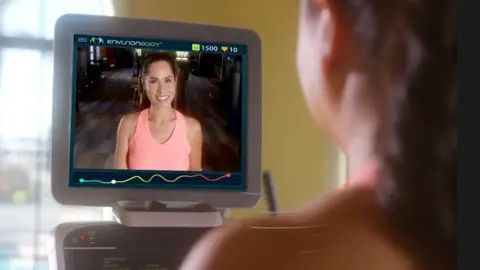 Envisionbody
EnvisionbodyIt plans to work with gym equipment-makers to show idealised versions of users' physiques as they work out.
Whatever the physical benefits, the firm will face questions as to what effect this would have on users' mental health.
OTHERS
And there's more.
Impossible Foods' chief executive is hosting a press conference as well as headlining a high-profile dinner. He's already acknowledged work on a follow-up to the firm's plant-based beef substitute, so is it ready for mass consumption?
Big smartphone news is typically held back for Mobile World Congress in February. But OnePlus will have a concept handset at CES that hides its rear cameras when they are not in use by electronically tinting an otherwise transparent glass panel above them.
Samsung could also have more to disclose about a folding design it trailed in October.
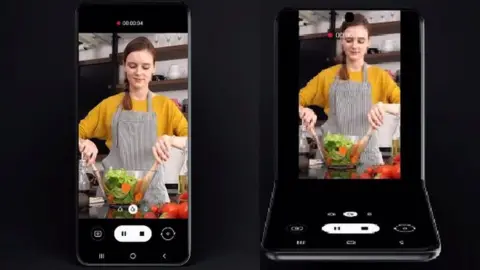 Samsung
SamsungOthers are working on ways to retrospectively turn existing handsets into foldables.
The makers of the Castaway will show off progress on a flip-open case that doubles as a detachable second screen.
And Pocket Display aims to go one better with an add-on that trebles the owners' view.
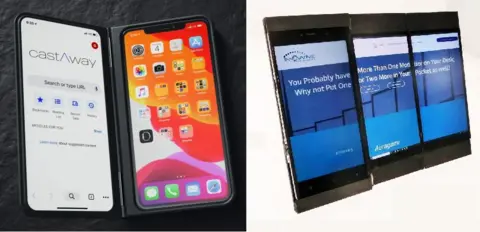 Castaway/Pocket Monitors
Castaway/Pocket MonitorsPlenty of gadgets will be of even more questionable value.
Does the world really want a circular handset?
Is there truly a gap in the market for a table-in-a-suitcase?
And are dog owners crying out for a harness to show them how their pet is feeling?
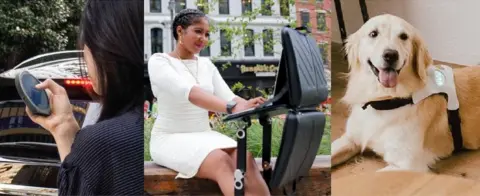 dTOOR/MyMoDesk/Inupthay
dTOOR/MyMoDesk/InupthayThese may seem like money-losing nightmares. But bad ideas are sometimes the stepping stones to good ones.
So with that in mind, who can be sure that Procter & Gamble's Rollbot - a smartphone-controlled robot that fetches you more loo paper when you run out - might not go on to wonderful things after its CES 2020 debut?
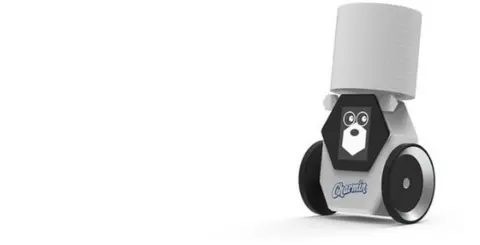 Procter & Gamble
Procter & Gamble